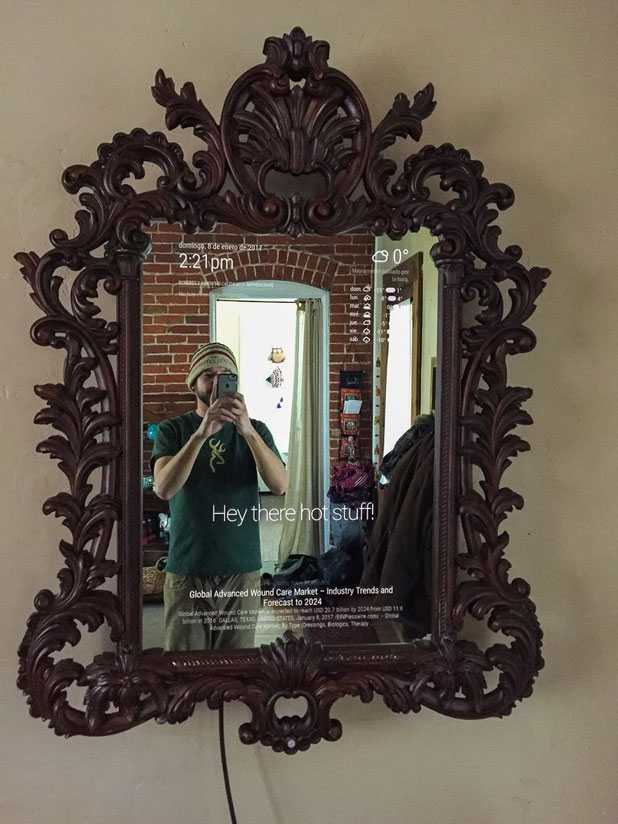

Like most smart mirror projects the technological elements are all hidden the screen is behind a one-way mirror, speakers are out of sight, and the only inputs are a gesture sensor and a microphone embedded into the frame. For its intended audience of curious children fascinated by the written and spoken aspects of language, it’s part interactive toy and part learning tool. A mirror in more ways than one, it listens and repeats back, while writing out what it hears at the same time. From an application perspective it’s fairly simple, but what’s interesting is the use of speech-to-text and text-to-speech functions not as a means to an end, but as an end in themselves. Anything it hears, it then displays on the screen and reads back to the user. Magic Mirror waits for activation (a simple pass of the hand over a sensor) then shows that it is listening. The magic is all in the simple interface. Inspiration came from his own five-year-old, who can neither read nor write but nevertheless has a bottomless fascination with the writing and spelling of words, phrases, and numbers. ’s Miroir Magique (“Magic Mirror”) is an interesting take on the smart mirror concept it’s intended to be a playful, interactive learning tool for kids who are at an age where language and interactivity are deeply interesting to them, but whose ceaseless demands for examples of spelling and writing can be equally exhausting. Those are so useful.Ĭontinue reading “Smart Mirror Talks To 3D Printers” → Posted in Raspberry Pi Tagged Magic Mirror, octomirror, Octoprint, raspberry pi, smart mirror We especially admire that once it was done, he hung it up with a French cleat.


built this in three days on an apartment balcony using a minimum of tools. We think this would be a good early woodworking project or something for a long weekend. designed and printed some corner support brackets that double as leveling screw holders to get the acrylic panel dialed in just right, and you can get these for yourself from GitHub. That isn’t a piece of mirror glass, it’s actually one-way acrylic which is lighter and somewhat cheaper. The only tricky part is power, because the LCD is going to need so much more voltage than the Pi and the absolutely necessary LEDs around the edge, but a couple of buck converters do the trick.Īfter stripping the monitor of all of its unnecessary plastic, cut rear and front frames to support the electronics. The electronics are pretty simple here - used the guts of an old monitor for the display and a Raspberry Pi to serve up the modules as a web page. Thanks to projects like ’s MagicMirror, everything is done with modules, including really useful things such as OctoMirror that let you keep an eye on your 3D printer(s) using OctoPrint. In ’ case, that data includes 3D printer activity on the network - something that’s way more relevant to daily life than say, headlines about Kim Jong Un’s weight loss progress. You know, a mirror connected to the internet that shows information like news, weather, or whatever you want, right there on top of your stunning visage. As time goes by, it’s only getting easier to make a magic mirror.


 0 kommentar(er)
0 kommentar(er)
